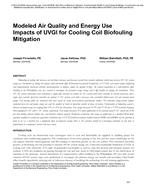Description
Biofouling of cooling coils increases air-side flow resistance and decreases overall heat transfer coefficient, which may increase HVAC systemenergy use. Irradiation of cooling coil surfaces with ultraviolet light (Ultraviolet Germicidal Irradiation, or UVGI), can control surface biofoulingand simultaneously inactivate airborne microorganisms to improve indoor air quality (IAQ). An annual simulation of a representative officebuilding in the Philadelphia area was created to investigate the potential energy savings and IAQ benefits of cooling coil irradiation. ThreeHVAC system alternatives were considered: a single-zone constant air volume (CAV) system with either constant or variable speed fan, and asingle zone variable speed fan (variable air volume) VAV system, each with a two-way valve controlled chilled water coil and constant speedpump. Coil fouling effects for untreated coils were based on recent peer-reviewed experimental studies. The principal energy-related outputsevaluated were fan and pump energy use and the number of hours of operation outside of space set points. Elimination of biofouling caused adecrease in pump energy use ranging from 15% to 21% for all systems. Fan energy decreased 15.3% and 27.3% for a VFD (variable frequencydrive)-equipped CAV and VAV system, respectively. Fan energy increased 12% upon application to the constant speed CAV system due to thefact that fouling reduced airflow rate, and therefore reduced capacity. Prediction of infection risk using an application of a modified Wells-Rileyequation modified to account for equivalent ventilation due to UVGI predicted economic benefits between $5000 and $20000, but the question ofwhat to use as a baseline has a significant effect on projected savings (that is, the economic benefit of a percentage reduction in sick leave isproportional to a company’s current sick leave rates).
Citation: IAQ Conference: IAQ 2013: Environmental Health in Low Energy Buildings
Product Details
- Published:
- 2013
- Number of Pages:
- 8
- File Size:
- 1 file , 2.2 MB
- Product Code(s):
- D-2013IAQConf-30




